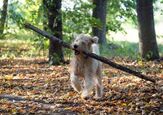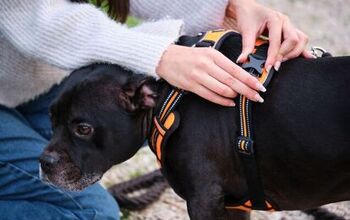What Is the Best Dog Breed for Children?

If your kids have been begging for a dog and you’re finally ready for your family to grow by four paws, congratulations! It’s an exciting time. You are likely picturing happy afternoons together at the park, playful cuddles on the couch, and a pup who will grow with your family – especially with your child. But with so many dog breeds to choose from, finding the right fit can be overwhelming.
You may have heard whispers of “the best dog breeds for kids.” Many online articles list Golden Retrievers, Labradors, and even some smaller breeds as the ideal family dog. While it’s true that these breeds are often friendly and playful, the truth is that the “best dog for kids” will depend on more than just the breed.
In this guide, we will look at the most important factors and considerations when choosing your next family dog. Plus, we have collected some expert advice that may surprise you.
Remember, the secret to finding the perfect dog for your family lies in research, careful consideration, and a commitment to doing right by both your children and your new pup.
Debunking the Myth of the “Perfect” Family-Friendly Dog Breed
While some breeds are better known for their family-friendly behavior traits, we must remember that every dog is an individual. Just like humans, dogs of the same breed may come with a wide range of personalities. Some may be more playful and tolerant of young children, while others may be more independent, nervous, or prone to anxiety.
Furthermore, your dog’s personality isn’t solely based on their genetics. Much of a dog’s temperament is influenced by their upbringing. Proper socialization and training from a young age, regardless of the breed, can help your dog learn what behaviors you deem appropriate (especially around children).
So, while some breeds are more likely to be a good fit in a family home, we must always remember that there is no guarantee!
Factors to Consider When Choosing a Dog
When deciding on your dog’s breed or the individual dog themselves, there are a few important factors to consider. This includes:
Living Situation
I firmly believe that a dog can thrive in just about any living situation given the right dedication from their humans, but choosing a dog that is well-suited for your situation will set you and your new dog up for success.
Do you live in an apartment? A smaller, quieter (less barking), low-shedding dog breed may be a bitter fit than a larger, high-energy dog. If you have a house with a yard, you’ll have more space for an active pup to exercise and play.
Other factors to consider include whether you have a fence (some dogs, like the Siberian Husky, are a bigger flight risk) and the amount of space within your home, especially if you’re considering a larger dog like a Great Dane.
Family Lifestyle
Does your family enjoy going for long hikes? Is there someone in your home who goes for a daily run and would love a dog interested in joining them? Or are you more of a couch potato bunch? Recognizing your family’s lifestyle will help you choose a dog breed that matches your vibe.
A high-energy breed like the Border Collie is an excellent choice for an active household, but they may become bored or destructive if they aren’t getting enough exercise. On the other hand, a more relaxed and laid-back dog like the English Bulldog may struggle to keep up with the demands of a more active family.
Your Child’s Age and Maturity Level
Up to this point, we have been talking about family-friendly dogs as if all children are created equally. But this clearly isn’t the case. The patience, understanding, and maturity of a 10-year-old child will be considerably different than that of a young toddler. Even within a specific age bracket, some children will be more mature and more willing to help with the dog than others.
No one knows your child(ren) better than you. Take a moment to consider your child’s maturity level, personality, and specific needs in a dog.
Commitment to Training and Socialization
Training and socialization are essential for all breeds, but some dogs will likely need a little extra work to set them up for success in a home with kids.
For example, a herding breed with natural herding instincts may be more tempted to wrangle your children. This may not seem problematic until you consider the fact that breeds like the Australian Cattle Dog herd livestock by nipping at their heels.
When selecting a dog breed, consider how much time you’re willing and able to dedicate to their ongoing training and socialization.
Allergies
If anyone in your family suffers from allergies, including the extended family who often comes to visit, you may want to consider a hypoallergenic breed. The term is slightly misleading, as no dog breed is 100% allergy-free. However, dogs that are considered hypoallergenic generally shed less or produce less dander.
Always Meet Potential Dogs
Now that you’ve narrowed down your breed options, it’s time to meet your potential new pup. Here are a few key steps to take to help you make the best choice:
- Visits Shelters and Rescues: If you’re leaning towards rescue, there are many great dogs of all breeds, mixes, and ages waiting for a loving home—the best way to find that “perfect fit” is to visit with the dogs in person. Talk to the rescue volunteers and foster parents (if possible). They know the personalities and quirks of each dog first-hand.
- Meet with a Reputable Breeder: Have you fallen in love with a specific breed? If so, a reputable breed will be a great source of information. Ask about the breed, their usual temperaments, common health issues, and other information you should know when deciding if it’s a good match for your family. If you find a breeder you trust, ask to see the mother with her litter. Ask questions about the parents to better understand what you may see in your new puppy.
- Spend Time with the Pup: Do you have your eye on a specific pup? If so, spend some time getting to know them. This is your chance to see their behavior. Are they playful and curious or shy and timid? Does that align with your family’s needs? Let your child meet the dog in a supervised setting and watch how they respond to one another. This can be really telling!
Most Popular Dog Breeds for Kids
While I started this article pointing out that no one breed is best for kids in every situation, there are a few breeds that generally rank really high in their family-friendly nature. This shouldn’t be the only factor you decide based on, but it is often a great starting point for those without any idea where to start their search.
Labrador Retrievers and Golden Retrievers constantly top lists of kid-friendly dog breeds, and for good reason. These breeds are known for their outgoing, friendly, and patient temperaments. This means they are naturally playful and more forgiving of the unpredictable and energetic nature of children.
Another reason trainers and animal professionals recommend these dog breeds is their trainability and eagerness to please. They are smart, easy-to-train dogs, which is key for a well-behaved family dog. As a bonus, they are also generally healthy dogs with a long lifespan, meaning you will likely enjoy many years with your newest family member.
Recently, Amdam Spivey from Southend Dog Training in the UK took to TikTok to share his recommendation for the best family-family dog breed – the Staffordshire Bull Terrier. His opinion drew much attention because this breed is often overlooked when discussing dogs for kids. He described the breed as the best for people, best for children, and a dog that generally presents very fear or discomfort with strangers.
“Often nicknamed a nanny dog by people that love the breed, the Staffordshire Bull Terrier is notoriously great with people and notoriously great with children,” Spivey explained.
Of course, as we already discussed, individual dogs can have unique personalities even within these well-known and trusted breeds. These recommendations are a great starting point, but always meet and get to know the specific dog you are considering before committing.
Preparing For Your New Dog
So, you’ve chosen your new family dog. Congratulations! But before you welcome a new pup into your home, it’s time to prepare your living space (and your family members). Just like bringing home a new baby, adding a dog to your family will require some adjustments and preparation.
Puppy-Proofing Your Home
Just as you would for a young child, you need to puppy-proof your home for your new dog. Take time to look around any room your dog will have access to, identifying and addressing any potential hazards, such as electrical cords, small objects that could be swallowed, and toxic plans. Put away breakable items and ensure that medications and household cleaning products are stored safely out of reach.
These steps are often associated with puppies, but you should go through the process even if you’re adopting an older dog. You never know whether your new pup will have bad habits or act inappropriately in the beginning due to stress from all these life changes.
Teach Your Child(ren) How to Interact with Dogs Safely
One of the most important things you need to do when introducing a dog to your family is teach your child(ren) how to interact with dogs safely. Children need to understand that dogs are living beings with their own feelings, needs, and boundaries. This is a great learning opportunity, both to show your child(ren) how to interact with their own dog and to discuss dog safety around other dogs, too!
Children should be taught to approach any dog calmly and gently, avoiding sudden movements or loud noises that could frighten them. Show them how to gently pet a dog and teach them the importance of avoiding pulling on fur, ears, or tails, which can be painful.
It’s also important to teach children to respect the dog’s space and boundaries. If the pup is lying down, eating, chewing on a toy, or seems to be avoiding interaction, this is a time that they should be left alone. Wait for a dog to come to you to interact with them on their terms, avoiding putting them in a position where they may feel startled or uncomfortable.
Never leave your child unsupervised around a dog, regardless of the breed or temperament. Even the most gentle dog may be startled or overwhelmed, causing a temporary lapse in judgment. Accidents can happen quickly.
Create a Quiet Area for Your Dog
If your dog feels overwhelmed or anxious, it can put them on edge, creating a situation that could escalate into something more dangerous for everyone involved. One way to prevent this is by creating a quiet area or safe space they can retreat to when they know they need a moment alone.
Your dog’s safe space could be a designated corner of a room, a spare bedroom they can access, or even their crate set up somewhere out of the way. The goal is to make a space that is quiet and relaxing. I highly recommend crate training with a reliable crate like the MidWest Homes for Pets Double Door iCrate. Incorporate a familiar blanket or a favorite plush toy unless they are the type of pup to chew up/ingest these items when unsupervised.
Set (and Enforce) Clear Rules and Boundaries at Home
This doesn’t just mean setting rules and boundaries for your new dog. The same will be needed for every member of your family if you are going to set yourself up for a happy home. Your household rules will need to include structure, like feeding, playtime, and bedtime. Consistency and routine will help your dog settle in while building a lasting relationship between your dog and your family.
Ongoing Training and Socialization
After bringing your new dog home, ongoing training and socialization are crucial to help them adjust and learn what’s expected of them. Enrolling in basic obedience classes is a great start, especially for families with children. They will help teach your dog the foundation they need, like “sit,” “stay,” and “come.” Training is also a great way to strengthen the bond between you and your dog.
Beyond formal training, consistent socialization is essential. Expose your dog early to various people, places, and situations. This helps them become confident and comfortable around different environments and experiences. A well-socialized dog is more likely to be relaxed and friendly, making them the best possible companion for your child(ren) and you.
Final Thoughts – The Best Dogs for Children
Finding the right dog for your family is a journey. It requires research, careful consideration, and a commitment to putting in the work. Remember, the most important factor is finding a dog that is a good fit for your entire family.
But if you’re willing to put in the time and effort needed, you can set yourself (and your family) up for many years of joy and companionship with a well-behaved family dog.
Join the PetGuide community. Get the latest pet news and product recommendations by subscribing to our newsletter here.

Britt Kascjak is a proud pet mom, sharing her heart (and her home) with her “pack” which includes her husband John, their 2 dogs – Lucifer and Willow – and their 3 cats – Pippen, Jinx, and Theia. She has been active in the animal rescue community for over 15 years, volunteering, fostering and advocating for organizations across Canada and the US. In her free time, she enjoys traveling around the country camping, hiking, and canoeing with her pets.
More by Britt
























